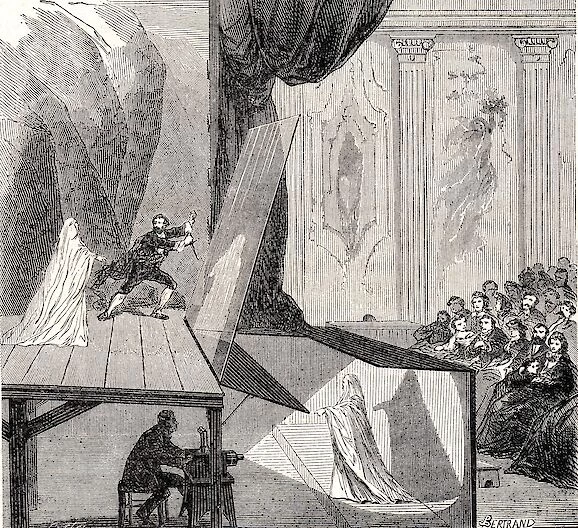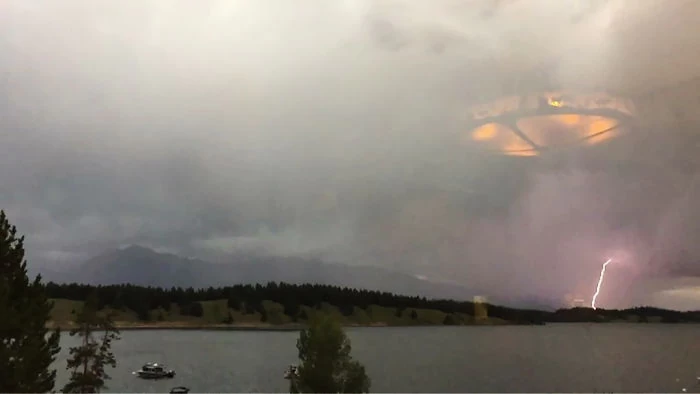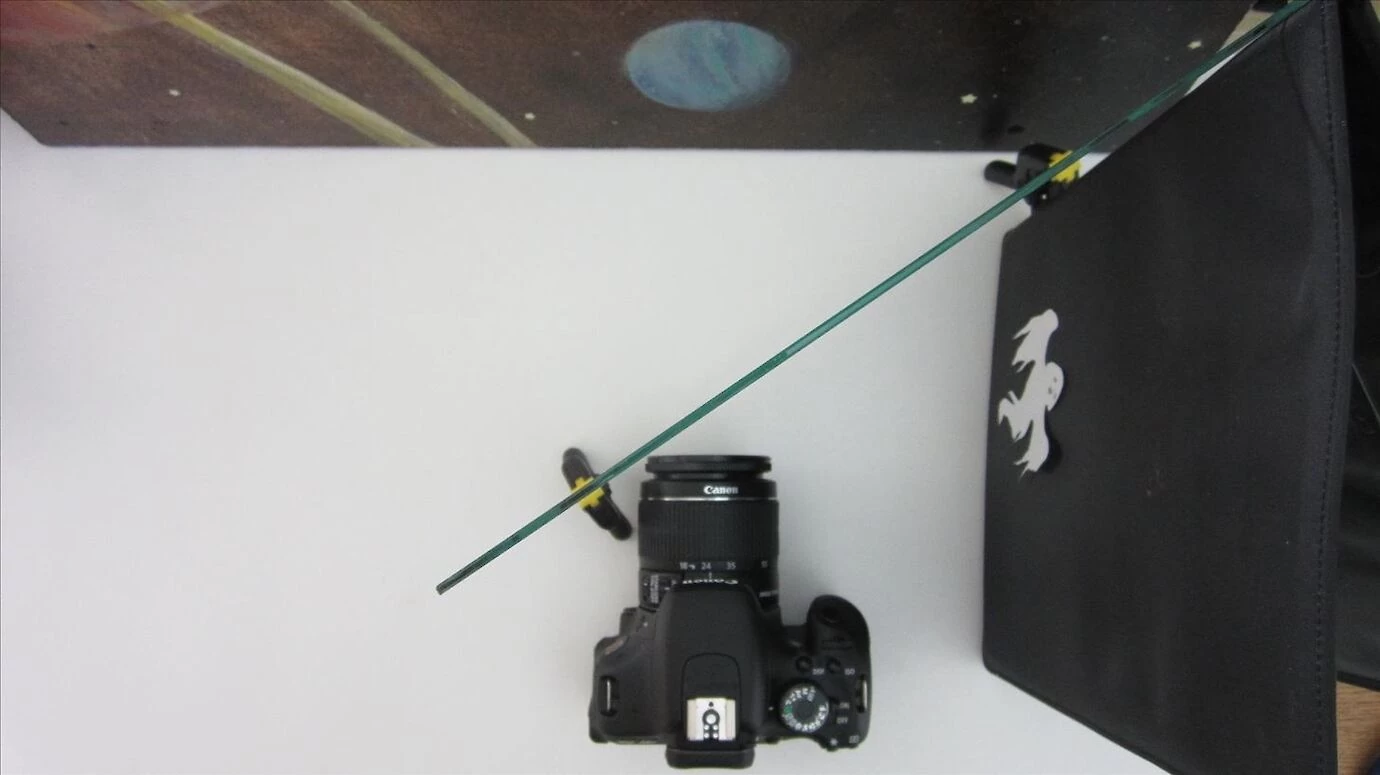

Pepper’s Ghost
Pepper's Ghost is a trick illusionists use to project an image. It is similar to the way a hologram works. While it is a trick used in 'haunted houses' for entertainment, it is something that you can also unknowingly capture on camera under the right set of circumstances and something paranormal investigators should be aware of.
What is pepper's ghost?
Pepper's ghost is an illusion that was named after Scientist John Henry Pepper who demonstrated this effect in 1862. It is popular among magicians and illusionists and is also used to project images like holograms.

Image Source: Public Domain
In 1860, inventor Henry Dircks built an optical illusion dubbed Dircksian Phantasmagoria which used glass and light to project an optical illusion. It was very complicated and never really gained much popularity as theatres needed to completely rebuild their stage to be able to use it making it an expensive option. John H Pepper came up with a way to recreate this effect using the existing stage areas in theatres.
It involves using a large piece of glass at an angle between a brightly lit stage and a hidden room (much like the image above). When you illuminate the 'hidden room', the lights on the stage are brought down and the image in the hidden room is reflected onto the stage and appears as a ghostly apparition.
Pepper’s Ghost can be explained using ray optics. To start, the glass, or transparent film, used in a Pepper’s Ghost illusion has a different refractive index than the air around it; that is, light in the two media propagates at different speeds. When light reaches a boundary between two materials with different refractive indices, typically some of the light is reflected and the rest is refracted, or transmitted at an angle. The amount of light that is reflected and refracted is governed by the Fresnel equations and depends on the angle of incidence and polarization of the incoming light, as well as the neighboring materials.
Consider the setup used for the classical Pepper’s Ghost illusion, consisting of a stage, an additional room out of direct sight of the audience, and a wall of glass angled between the audience and both rooms. The light from the lit-up stage is refracted as it enters and leaves the pane of glass. The audience can see the stage, but not the glass, just as if they are watching any old stage play. When the lights in the side room are turned on, light propagates from the “ghost” to the glass. Some of the light is reflected by the glass and reaches the audience. The crowd sees rays of light from both the regular stage and the hidden room. This projects the hidden image in a semitransparent, or “ghostly”, manner.
https://www.comsol.com/blogs/explaining-the-peppers-ghost-illusion-with-ray-optics/
Can you photograph this by accident?
So essentially, it is a case of reflection. It is something that you can unknowingly create when you are taking a photograph through a window. There was recently a photo on social media that appeared to be quite convincing at first glance, however, it was soon discovered that it was a case of reflection from inside the car. All it takes is to have the camera or even smartphone at the right angle and you will pick up this reflection.
Image Source: https://digital-photography.wonderhowto.com/how-to/add-creepy-apparitions-your-halloween-photos-using-peppers-ghost-illusion-0148917/
Here is a great example of how this can even be recreated using a smartphone:

Image Source: https://rimstar.org/science_electronics_projects/peppers_ghost_on_a_phone.htm
While some people use this technique to deliberately deceive and make it appear like they have caught an apparition, it is something that can also happen accidentally. It is understandable why someone could confuse this with being something paranormal, especially if they are unfamiliar with their surroundings.
A common example I have seen is people taking a photograph from a high-rise building of the view. Upon review, it looks like they have captured something strange in the sky. It could even be a coloured light (often red). Many start to think that maybe they have caught a UFO. In many cases, however, it is a red light reflection from the smoke alarm on the roof. Below is an example of a person who has taken a photo from inside of a bolt of lightning. It looks like there is a pretty amazing UFO at first glance! The problem is, the UFO is exactly the same as the light fixture in the very room they were shooting the photo. This is the perfect example of how this illusion can trick a person using a camera.

Image Source:https://www.boredpanda.com/amazing-reflections-optical-illusions/
I can think of many ways that this can deceive a person during a paranormal investigation, even when not using a camera. A lot of historical places have displays that use glass and perspex to block off areas or to protect old artefacts. Investigators are often walking around these places in the dark with a flashlight or a form of light source. It could be very easy for an image to bounce off this glass and make a person think they are seeing something. While some will knowingly use this optical illusion to deceive, there are people who are genuine with their intentions but are unaware that what they have captured is just a case of reflection. Lighting is one of the key ingredients when it comes to taking a photo. We have all been there and accidentally caught a reflection or lens flare etc in our shots. The important thing when using a camera even if it is a smartphone is to understand how light and photography works. Then you can truly start to understand what is happening in your photos.
So next time you capture a UFO or even what you believe to be an apparition, look at your surroundings for any reflective surfaces. See if there is a light source. (Remember even if you are using a camera that is converted to IR or shooting in night shot, it can still pick up reflection if there is a light source). Try to recreate the photo under the same set of circumstances. Turn the lights on and see what is around you. Once you can start to eliminate all of these things, not only will you understand things a bit better, you will find you become better at taking photos as you know what angles, etc to avoid. All of this makes us better investigators!
References
https://digital-photography.wonderhowto.com/how-to/add-creepy-apparitions-your-halloween-photos-using-peppers-ghost-illusion-0148917/
https://www.comsol.com/blogs/explaining-the-peppers-ghost-illusion-with-ray-optics/
World of the unknown: Ghosts by Christopher Maynard 1977
https://rimstar.org/science_electronics_projects/peppers_ghost_on_a_phone.htm
https://www.boredpanda.com/amazing-reflections-optical-illusions/
If you enjoy LLIFS, consider buying me a book (otherwise known as buy me a coffee but I don't drink coffee and I LOVE books). Your donation helps to fund the LLIFS website so everyone can continue to access great paranormal content and resources for FREE!

Top pages with similar subjects
Don't forget to follow the Facebook page for regular updates
Join the mailing list to receive weekly updates of NEW articles. Never miss an article again!
Buy the latest and past issues Haunted Magazine
Check out the books written by LLIFS
